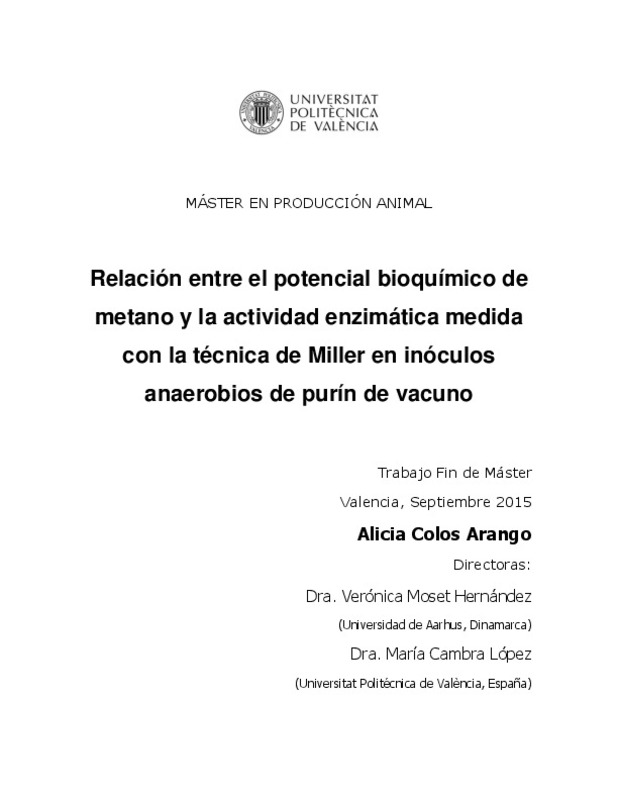|
Resumen:
|
[EN] Four inocula from cow manure monodigestion and the codigestion of cow manure with ensiled and
pretreated prairie grass, of which: first, the intermediate products of hydrolysis of cellulose and wheat
straw in the ...[+]
[EN] Four inocula from cow manure monodigestion and the codigestion of cow manure with ensiled and
pretreated prairie grass, of which: first, the intermediate products of hydrolysis of cellulose and wheat
straw in the inoculum were measured through the production of sugars by the technique of Miller
(DNS); and second, the effect of inoculum on the parameters of anaerobic degradation
(biodegradability) of cellulose and the wheat straw by the potential of methane biochemist (BMP)
through a model of Hashimoto and Gompertz were studied. Finally, both methods (DNS and BMP)
were related. The inocula came from four continually stirred tank reactors: inoculum 1 (I1, 100% cow
manure), 2 inoculum (I2, 95% cow manure with 5% excoriated excoriated grass), inoculum 3 (I3,
95% cow manure with 5% of chopped grass) and inoculum 4 (I4, 95% cow manure with 5% of
untreated grass). As substrates, cellulose and wheat straw were used. The DNS, allowed to
differentiate the enzymatic activity of cellulose and the wheat straw due to the influence of the inocula.
The results of the DNS showed that the rate of union the microbial substrate depends on the type of
bacteria that contains the inoculum. Between substrates, the concentration of reducing sugars from
cellulose was less than the straw in I2, I3 and I4. The inoculum has a great influence in the
determination of potential of methane at 90 days (B0). The cellulose showed a higher B0 in the
inoculum from the I1, while the wheat straw produced higher B0 in the inoculum I4. The cellulose was
more biodegradable than the straw in all inocula tested except in the I4, where straw of wheat was
more biodegradable that cellulose. In terms of the kinetic models, the maximum methane production
rate (μm) of the Gompertz model was directly related to the rate constant of the BMP (k) of the model
of Hashimoto and hydrolysis. We can link the technical information of the DNS and the of the
Gompertz model to predict that inoculum is more suited for a given substrate. However, it does not
provide information of adaptation and/or evolution of the bacterial substrate in the future. In order to
be able to relate more closely the DNS with the BMP would be necessary to perform the analysis of
DNS at different times of the BMP.
[-]
[ES] Se utilizaron cuatro inóculos diferenciados de la monodigestión del purín de vacuno y la codigestión del
purín vacuno con pasto de pradera pretratados y ensilado, de los cuales: primero, se midieron los
productos ...[+]
[ES] Se utilizaron cuatro inóculos diferenciados de la monodigestión del purín de vacuno y la codigestión del
purín vacuno con pasto de pradera pretratados y ensilado, de los cuales: primero, se midieron los
productos intermedios de hidrólisis de la celulosa y la paja de trigo en el inóculo a través de la
producción de azúcares reductores por la técnica de Miller (DNS); y segundo, se estudió el efecto del
inóculo sobre los parámetros de degradación anaerobia (biodegradabilidad) de la celulosa y la paja de
trigo por el potencial bioquímico de metano (BMP) a través de modelo de Hashimoto y de Gompertz.
Finalmente, ambos métodos (DNS y BMP) se relacionaron. Los inóculos procedieron de cuatro
digestores de tanque agitado continuo: inóculo 1 (I1, 100% purín de vacuno), inóculo 2 (I2, 95%
purín de vacuno con 5% de pasto excoriado), inóculo 3 (I3, 95% purín de vacuno con 5% de pasto
picado) e inóculo 4 (I4, 95% purín de vacuno con 5% de pasto sin tratar). Como sustratos se utilizaron
celulosa y paja de trigo triturada. La DNS, permitió diferenciar la actividad enzimática de la celulosa y
la paja de trigo debido a la influencia de los inóculos. Los resultados de la DNS reflejaron que la tasa
de unión microbiana al sustrato depende del tipo de bacterias que contiene el inóculo. Entre sustratos,
la concentración de azúcares reductores de la celulosa fue menor a la paja en I2, I3 e I4. El inóculo
tiene una gran influencia en la determinación de potencial de metano a 90 días (B0). La celulosa
produjo un mayor B0 en el inóculo procedente del I1, mientras que la paja de trigo produjo más B0 en
el inóculo I4. La celulosa resultó más biodegradable que la paja en todos los inóculos testados salvo en
el I4, donde la paja de trigo resultó más biodegradable que la celulosa. En cuanto a los modelos
cinéticos la tasa máxima de producción de CH4 (μm) del modelo de Gompertz está directamente
relacionada con la constante de velocidad del BMP (k) del modelo de Hashimoto y con la hidrólisis. Se
puede relacionar la información de la técnica de DNS y la del modelo de Gompertz para predecir
qué inóculo está más adaptado a un determinado sustrato. Sin embargo, no brinda información de la
adaptación y/o evolución bacteriana del sustrato en el futuro. Para poder relacionar más
estrechamente la DNS con la BMP sería necesario realizar el análisis de DNS en diferentes momentos
de la BMP.
[-]
|







